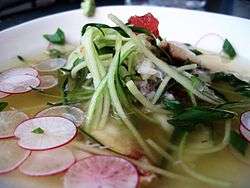Naengguk
|
A bowl of elaborated oi naengguk made with cucumbers | |
| Type | Guk |
|---|---|
| Place of origin | Korea |
| Serving temperature | Cold |
|
| |
| Naengguk | |
| Hangul | 냉국, 찬국 |
|---|---|
| Hanja | 冷국 |
| Revised Romanization | naegguk, changuk |
| McCune–Reischauer | naegguk, ch'anguk |
Naengguk refers to all kinds of cold guk (soups) in Korean cuisine, mainly eaten in summer. It is so called changuk, which literally means "cold soup" in pure Korean, while the term naengguk is a combination of a hanja word and a pure Korean word with the same meaning.[1]
The first historical record on naengguk appears in a poem written by Yi Gyu-bo (1168–1241), a high officer of the Goryeo period (918–1392). In the poem, naengguk is referred to as sungaeng, which literally means sunchaeguk, soup made with sunchae (Brasenia schreberi). Yi praised its clear and plain taste, saying it made usual dishes seem vulgar.[2][3]
Naengguk is largely divided into two categories according to seasoning and ingredients. The first category is made by mixing chilled water and vinegar to give a sour and sweet taste such as miyeok naengguk made with wakame, oi naengguk made with cucumber, pa naengguk made with spring onions, nameul naengguk made with garlic, and gim naengguk made with gim or nori. The other category is made to supplement health and has rich tastes such as chilled soup made with chicken, sesame, or soybeans.[2][3]
See also
References
External links
| Wikimedia Commons has media related to Naengguk. |
- Soups and stews from Food in Korea
